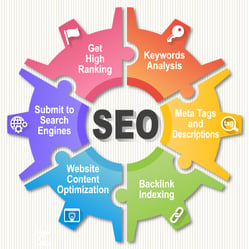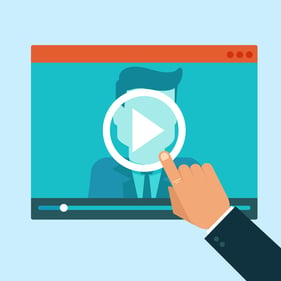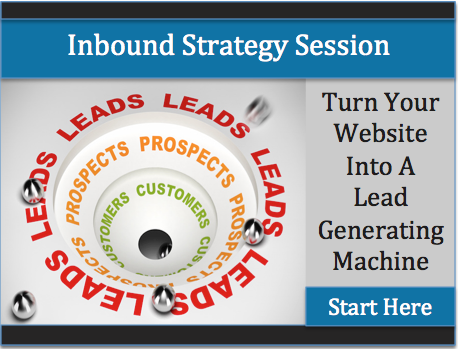Inbound marketing is a tactic focused on attracting customers through relevant and helpful content. Successful inbound marketing content adds value at every stage of a customer’s buyer’s journey. Through addressing common problems and educating consumers, inbound marketing helps attract qualified leads that are most likely to make a purchase. Inbound marketing focuses on guiding customers from one stage of the buyer’s journey to the next using expert content.

Why Use Inbound Marketing?
People live online. Not only do people do business and make purchases online, but most people do research online before ever contacting a company. In fact, 81% of shoppers conduct research before making big purchases. For this reason, providing educational content will allow your business to get to your customers earlier in their buyer’s journey. Additionally, when you produce high quality, targeted content, you will attract better leads that are more likely to make a purchase. Inbound marketing helps establish your brand as a valuable resource, helping potential customers sift through the thousands of business websites available to them to get to yours.
Stages of Inbound Methodology
There are four main stages of inbound marketing methodology: attract, convert, close, and delight. These stages all make use of different inbound marketing tools in order to turn a site visitor into a satisfied customer.
Attract
The first stage of inbound methodology is to attract. In this stage, the goal is to get potential customers that are on the Internet to end up on your site. Using targeted content, you can help educate potential customer throughout their research process and bring them to your website. The attraction stage leverages strong content to get the right people with the best chance of becoming customers to your site.
Convert
During the conversion stage of the inbound process, you’ll turn site visitors into leads. Once site visitors have discovered your content, you can offer them additional valuable content in exchange for filling out a form. These forms will provide you with contact information for these visitors, allowing you to contact them about becoming a customer. When visitors have provided you with contact information, they demonstrate interest in your business and become leads.
Close
Turning a lead into the customer is mostly the responsibility of your sales team. However, you can use inbound tactics to nurture your leads. Email marketing is a great way to keep in contact with your leads and provide them with additional useful content. When you combine inbound tactics with a expert sales team, your business will close more leads.
Delight
Smart inbound marketers know that closing customers is not the end of sales and marketing process. It’s important to delight your customers. In addition to providing new customers with valuable products or services, you should continue to provide them with valuable content that is relevant to them. This content can further educate them about your industry as well as products and services that might be useful to them that they are not currently investing in.
Tools of Inbound Marketing
Inbound marketers use countless tools to generate and convert leads. We’ve broken down some of the most important tools and tactics that lead to an effective inbound marketing strategy.
 Search Engine Optimization (SEO)
Search Engine Optimization (SEO)
Search engine optimization, or SEO, is a strategy that helps people find your company’s website on search engines. Successful inbound marketers understand the algorithms that Google uses to rank websites based on searches. Through blogging, reorganizing web pages, and leveraging keywords, marketers can make sure that Google ranks your site highly for the searches your potential customers are performing. SEO is a long-term process that builds over time, gradually establishing your company and its website as a leader in your industry, improving your search engine rankings.
Paid Search
Paid search, otherwise known as pay-per-click (PPC) marketing, is another method to ensure your website is visible on search engines. Smart inbound marketers use paid search in conjunction with SEO. In short, your business will pay to have your site visible on search engines when searchers enter certain keywords. Each time someone clicks on your site, you will pay a specified amount. Paid search can be turned off and on at any time, making it a great option to push a seasonal service or a product you have an excess of. SEO will organically build your long-term presence on search engines while PPC marketing will establish your presence immediately.
Blogging
Blogging is one of the most important aspects of an inbound marketing strategy. Blog posts are the content that will educate consumers, answer common questions, and add value during each stage of the buyer’s journey. Each blog post will be targeted at a different stage of the journey, from generalized posts created for people simply gathering information and doing research, to highly specific posts created for people making purchasing decisions. Not only does blogging help educate consumers while establishing your expertise in your field, but it also humanizes your brand, adding a personal voice. Blog posts will provide the content that will drive visitors to your site via search engines, social media, and referrals.
 Video
Video
Blog posts are an important part of your content strategy, but they are not the only form of content. Video content has goals similar to blog posts, such as educating consumers and answering important questions. However, the format is better suited to certain platforms. When conducting research on a search engine, you’re probably looking for written content to provide information. However, video content is more easily consumed and is well suited for social media platforms, where users’ attention spans are much shorter. Video content will provide information as equally valuable as blog content, but in a format that is much easier to consume.
Social Media
Social media is an important part of your inbound marketing strategy. It’s a great way to reach your potential customers and promote your business. You can share your content via social media. Video content is especially successful on platforms such as Facebook. You can create both organic and paid posts on social media. Organic posts will be visible when they receive significant engagement, meaning posts must be interesting and generate conversation to achieve visibility. Paid posts will be automatically visible. You can choose certain demographics, such as age, location, education, type of job, and more for your paid posts, meaning only people who fit your target audience will see them. Social media is an important tool to promote your content and your business to generate new leads.
Calls to Action
Calls to action are necessary to convert site visitors into leads. Calls to action are buttons that will appear on your content, at the bottom of blog posts, the side of a web page, or in the body of an email. These buttons offer something of value related to the appropriate stage of the buyer’s journey. It might offer a downloadable ebook attached to content aimed at an early stage of the buyer’s journey, or an opportunity to get a quote at the decision stage. When visitors click on calls to action, it will take them to a landing page with a form. They will need to fill out the form, providing contact information as well as information that will help segment buyer personas, in order to receive the offer. Once you attain their contact information, you can contact them in order to turn the lead into a customer.
-min.jpg?width=203&height=220&name=Depositphotos_76834347_l-2015%20(1)-min.jpg) Email Marketing
Email Marketing
Email marketing is an important part of your inbound marketing strategy. Emails are the best way to reach out to leads once you’ve collected their contact information. You can provide additional information about your business as well as content that they will find valuable. Within these emails, you can offer additional discounts to entice leads into making a purchase as well as new calls to action with additional valuable offers. Email marketing is the best way to remind leads about your business after they’ve left your site and help convert them into customers.
ImageWorks, LLC | CT Inbound Marketing Agency
Developing an inbound marketing strategy can be a daunting task. Many business owners walk into our office without knowing where to begin. Do not be discouraged. With technology and the digital marketing age moving as quickly as it does, we understand that you may have limited knowledge. We will always take the time to explain to you the process behind our projects. If something confuses you, you will never be judged for asking.
Combining blogging, SEO, social media, paid advertising, paid search, and other inbound marketing services, our experts will work with you to develop the ideal strategy for your business. We can help you generate leads and take your online presence to the next level!

